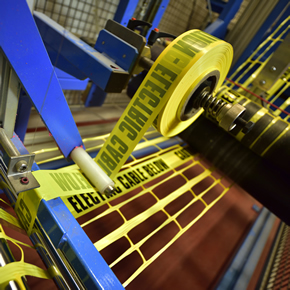
Why Hazard Warning Signs Are Essential for The Construction Industry
The following article looks at how hazard warning signs are a key risk mitigation tool in construction and that having the right ones in place is more than just a box-ticking exercise, with it also able to give your construction business a competitive edge.
The construction industry is one of the most high-risk in terms of accidents and injuries to both workers and visitors. Clearly, businesses have both a legal and a moral responsibility to protect health and safety. But it also makes sound commercial sense. Injuries result in lost man-days, costs and damage to reputation, none of which are good for business.
Having the right hazard signs in the right places is core to a construction site’s H&S practices and to instilling a culture of safety and wellbeing that is promoted across the site. While ensuring that employees feel comfortable about speaking out when it comes to near misses in order to improve processes is a positive step, it is always better to have the right signs in place before an incident can happen than afterwards. Here are some of the core areas that need to be considered.
Access
The last thing anyone needs on a construction site is visitors or the idle curious wandering around the place. Access signs ensure everyone knows what areas are off-limits.
When it comes to these types of signs, it is as important to tell people where they can go as where they can’t. Access signs are not just about Keep Out or Permitted Access Only. They also include the signs that tell visitors where they need to report.
Fire safety
It’s a prerequisite in any public place to provide clear and unambiguous information on what to do and where to go in the event of a fire. Clearly, this is even more important in a construction area, where the risk of fire is higher due to the activities going on. There is also a greater chance of layouts changing, new contractors arriving on site and so on, meaning people will not intuitively be aware of the nearest exit.
PPE
Accidents happen on construction sites. Objects fall, things spill, and sparks fly. PPE is every contractor’s first line of defence against the risks he or she faces – and it is the employer’s first line of defence in the event of a lawsuit. Being crystal clear on the PPE requirements in terms of boots, hard hats, gloves and so on is in everybody’s interest.
Motor vehicles
A construction site can get crowded with cars, vans and heavy plant competing with foot traffic for space. That sounds like an accident waiting to happen, so signs telling
drivers where to park, when to sound horns and in what areas they are likely to encounter pedestrians all help mitigate the risk.
Which signs do you need?
The above are some of the most common examples, but there are plenty of other types of signage you might need depending on the work undertaken, for example when working at height, where there is live electricity or when corrosive chemicals are in play.
HSE regulations demand that a risk assessment be performed on a regular basis, and identifying the need for additional safety signage should form an ongoing part of this routine.
Latest news

19th April 2024
ASSA ABLOY: Access solutions can impact sustainability performance across the full life-cycle of a building
Embedding sustainability within any organisation requires a broad, strategic perspective. Scrutiny should include the physical infrastructure itself: According to the IEA, buildings consume around 30% of global energy*. ASSA ABLOY has more…
Posted in Access Control & Door Entry Systems, Architectural Ironmongery, Articles, Building Industry News, Building Products & Structures, Building Regulations & Accreditations, Building Services, Case Studies, Doors, Facility Management & Building Services, Information Technology, Research & Materials Testing, Retrofit & Renovation, Security and Fire Protection, Sustainability & Energy Efficiency, Video of the Week
19th April 2024
British weather doesn't dampen spirit for new HMG Garden Paint
Despite one of the wettest starts to the year on record, customers are starting to plan for brighter days with HydroPro Garden Paint from HMG Paints.
Posted in Articles, Building Industry News, Building Products & Structures, Garden, Innovations & New Products, Paints, Paints, Coatings & Finishes, Restoration & Refurbishment, Retrofit & Renovation, Site Preparation, Sustainability & Energy Efficiency, Waste Management & Recycling
18th April 2024
Abloy UK showcases new digital portfolio at The Security Event 2024
Abloy UK is set to unveil its latest line-up of access control systems at The Security Event 2024, welcoming guests to explore its cutting-edge electromechanical and digital solutions on stand 5/F50.
Posted in Access Control & Door Entry Systems, Architectural Ironmongery, Articles, Building Industry Events, Building Industry News, Building Products & Structures, Building Services, Doors, Exhibitions and Conferences, Facility Management & Building Services, Health & Safety, Information Technology, Retrofit & Renovation, Security and Fire Protection
18th April 2024
Strand is a Failsafe Choice for Emergency Exit and Panic Hardware
In times of emergency, you’re in safe hands with Strand Hardware. Although there are many considerations for building specification, few decisions can be as critical as selecting the right emergency exit/panic hardware.
Posted in Access Control & Door Entry Systems, Architectural Ironmongery, Articles, Building Industry News, Building Products & Structures, Building Services, Doors, Facility Management & Building Services, Health & Safety, Restoration & Refurbishment, Retrofit & Renovation, Security and Fire Protection
 Sign up:
Sign up: